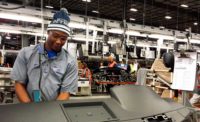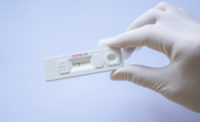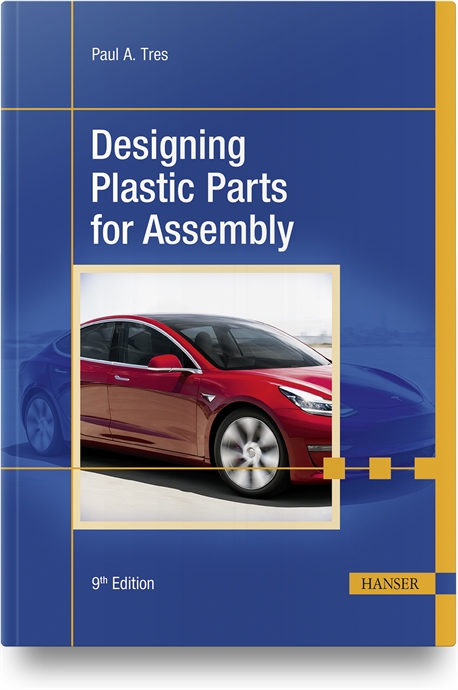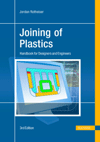
When welding textured parts, there is a strong possibility that the ultrasonic horn will mar the contact surface. Source: Dukane.
After carefully molding a beautiful product, nothing is worse than seeing it destroyed during assembly. Every joining process is capable of causing marking, flash, particulate, damage to appendages, or other aesthetic defects. With proper part design and processing, however, a finished weld can be imperceptible or even a cosmetic asset. The art to attractive bonding is specific to each process or type of product. Whether processing parts through ultrasonic, spin, vibration, hot plate, laser welding or thermal staking, methods exist to improve the appearance of the overall product after bonding.
Welding is a common necessity for a wide variety of industries, including medical, electronics and consumer products. Whether there are components that must be securely enclosed or the part geometry is too complex to be processed in one piece, a secondary joining step is often required.
A wide variety of products must have aesthetic welds or bonds-packaging clamshells is probably the most prominent example. Some other demanding cosmetic applications include vehicle headlamps and taillights, spoilers, battery enclosures, medical devices, toys, dishware and utensils, electronics housings, furniture and filters. For these products, and many others, melt flow must be contained, flash or particulate eliminated, tool marks prevented, and any other part damage eradicated.
The methods for preserving cosmetics are as varied as the welding processes available. Each assembly process can produce its own variety of decorative debacle. Fortunately, for each potential aesthetic issue, there is a solution.

Ultrasonic joints can effectively hide flash and produce a strong weld. Source: Dukane.
Ultrasonic Welding
Ultrasonic welding uses piezo-electric ceramics that convert electrical current into mechanical motion. High-frequency (15 kHz up to 90 kHz) vibrations are transmitted through the plastic part to the joint where intermolecular stress and strain cause melting of the surface of both parts, and welding. Ultrasonic welding is used for a variety of applications including clamshells, electronics housings, medical applications and fabric welding.One of the most common cosmetic defects that result from ultrasonic welding is flash-melted material that is pushed out of the joint at the weld interface. In addition to being unsightly, flash can also be a functional defect in certain applications. For example, air or water filter housings usually cannot have flash internally.
Through proper joint design, flash can be easily avoided. Generally, in production, there is balance between weld strength and amount of flash. In order to achieve greater strength, more collapse of the joint is required, and more flash is produced. Simply adding a flash trap to the part design, however, can allow sufficient strength with no flash.
A second common defect with ultrasonic welding is de-gating of small features in the assembly during the weld. Because ultrasonics depends on high-frequency vibration of the parts, there is a chance for cracks to form in areas with sharp corners or small cross-sectional areas. Sometimes these cracks are so severe that small features can be completely sheared off or de-gated.
There are two main ways to prevent this type of damage. One can either increase the radii or cross-section of the troubled area, or decrease the amplitude of the process. Reducing the amplitude, however, often has a negative impact on the weld, as it essentially reduces the energy available to weld the parts. Therefore, whenever possible, it is best to eliminate small or fragile features when ultrasonic welding will be used.

One cosmetic drawback to spin welding is that it generates a significant amount of flash. Source: Dukane.
Surface Marking
When welding textured parts, there is a strong possibility that the ultrasonic horn will mar the contact surface. On textured surfaces, there may be shiny places where the texture has been removed during welding. To prevent this occurrence, simply put a layer of thin film between the part and the horn.Marking can also occur when the horn leaves a residue on the part. Such residue is most often seen with aluminum horns or titanium horns that are welding white parts. Using chrome-plated aluminum horns is the best way to prevent this type of problem.
As mentioned earlier in the article, clamshell packaging is one of the biggest areas where cosmetic assembly is required. Ultrasonic welding is often used for such applications. A wide range of weld patterns have been developed to improve the appearance of such welds. These same patterns can also be used for welding of fabrics. In fact, fabrics can be welded using ultrasonics similarly to how they can be sewn, using a rotating anvil under a stationary horn that is operated by a foot pedal.
Spin Welding
Another common welding process is spin welding. In this process, one of the parts is held stationary and the other is spun at high revolutions per minute to generate frictional heat at the circular joint. While spinning, the parts are pressed together to form a weld. Spin welding is often used to join pipes, insulated cups or bowls and filter housings.The biggest cosmetic drawback to spin welding is that it generates a significant amount of flash. Unlike ultrasonic welding, the parts are moving during the weld process, meaning that the melt layer is also in motion. Subsequently, more melt must be generated to ensure good contact between the parts and a strong weld.
As a result, for every application where aesthetics is a concern, the part should be designed to hide the melted material. With out-of-round parts, however, it is often not possible to contain the flash simply by using a different joint design. In these instances, a secondary flash removal step is required.
In addition to solid pieces of displaced material, spin welding tends to generate tiny particles or plastic dust called particulate. Many times, particulate can simply be blown out after welding, but sometimes it cannot be present at all, such as with medical or food industry applications. Reducing the rotational, spin-welding speed reduces particulate generation. Soft materials such as polypropylene tend to produce much more particulate during welding.
With spin welding, like most other welding processes, there is the possibility of leaving tooling marks on the parts. Typically, this occurs on the upper part when it is not securely held in place using designed driving features. Tooling marks occur when the upper part slips in the tool. When the fixture is made of urethane, this can cause black marks on the parts. When it is made from stainless steel or aluminum, it can leave gouges in the parts.
To avoid this type of marking, it is essential to provide driving features on the part itself. A driving feature is some type of protrusion or depression on the upper part upon which the upper tool can apply rotational force. In addition, the parts should have relatively consistent external dimensions.

Vibration welding requires driving features to prevent tooling marks. In the absence of such features, a knurl pattern may be used to grip the part. The use of a knurl, however, will cause abrasions on the part. Source: Dukane
Vibration Welding
Vibration welding is one of the most often used welding processes for large parts, such as headlamps and taillights, intake manifolds and even furniture. In this process, one part is held stationary while the other is vibrated horizontally on top of it at low frequency (120 Hz to 240 Hz) and high amplitude. During this vibration, the upper part is pressed down onto the lower part to create the weld.Such welding depends on the movement of large amounts of melted material to generate a weld. Therefore, joint design is critical for flash containment. With the proper design, a strong, flash-free weld can be achieved consistently.
Similar to ultrasonic welding, the movement of the parts during vibration welding can cause de-gating of small features. The high amplitude used in vibration welding causes excess stress on large projecting features. De-gating is especially likely to occur when the base of the feature has a small cross-sectional area or sharp corners.
Vibration welding also is similar to spin welding in that driving features on the part are required to prevent tooling marks. In the absence of such features, a knurl pattern may be used to grip the part. The use of a knurl, however, will cause abrasions on the part, which should be taken into consideration during the design process.
If such marking is not acceptable, a urethane upper tool can sometimes be used to prevent scratches on the part. Often, a vacuum must be used with urethane tooling to provide sufficient holding force. Whatever tooling material is used, the parts must still be kept as dimensionally consistent as possible.

Properly designed vibration joints will show no flash. Source:Dukane.
Hot Plate Welding
With hot plate welding, two parts are pressed against or brought into close proximity of a heated surface to generate a melt layer, then pressed against each other to complete the weld. In this style of welding, the joint may be contoured quite extensively and strong hermetic welds are generally achievable. Nothing can be captured inside the parts, however, as any internal components would be damaged by the hot plate. Hot plate welding is often used for large pipes or tanks.Although hot plate welding generates a lot of flash, it is the most controlled, aesthetically pleasing flash of any weld process. The melted material pushed out of the joint when the two parts are pressed together forms a rounded line that can almost look as if it was designed to be there. If the double line of melt does not suit the application at hand, however, it can be hidden with a change of the joint design.
One of the unique potential cosmetic issues with hot plate welding is out-gassing. When plastic is heated, it emits gasses that can discolor the parts when they are welded, especially on metalized surfaces. This can be eliminated by applying a vacuum to one of the parts to extract the fumes before they can cause any discoloration or degradation.
In addition to discoloration, parts can be warped during hot plate welding, due to the high heat input used. The best way to prevent this is to use thicker part walls. Excess warping can also be avoided by using vacuums and clamping in the tooling to keep the parts in the correct shape during the weld.

Laser welding is one of the cleanest joining methods available. Source: Leister Corp.
Laser Welding
One of the newest polymer joining processes is laser welding-which is growing in popularity, particularly for medical applications. This assembly method uses a focused laser beam to heat the weld joint. The two parts are simultaneously pressed together to create the weld. Laser welds are known for being very clean, and flash and particulate free. Laser welding never causes de-gating of features and doesn’t generally cause warping. Still, for some components, there is potential for cosmetic defects.If improperly set up, there is a chance that surface degradation will occur during this welding process. This happens if the top part absorbs too much of the laser energy or if the bottom part absorbs too little. By changing the focal point of the laser this can be adjusted, but it is best avoided by choosing the materials with good laser welding properties at the outset.
The greatest potential for aesthetic flaws in an established process is marring from dirt or dust that is burned by the laser during the weld. Any dust in the path of the laser will absorb the weld energy and cause a disparity in the weld. To prevent marring, it is important to maintain the cleanliness of the lens and the weld joint.
Burning can also appear in the process set-up phase as over-welding. To resolve, one can decrease wattage to lessen the laser energy or increase the travel speed of the laser. In some systems, over-welding can be eliminated by adjusting the focus point of the laser so that it is further from the part.
Thermal Staking
Thermal staking is a method of mechanically bonding two parts by melting and reforming one of the parts to contain the other. Most often, a post on the part with the lower melting temperature is melted and formed into a dome shape to hold in the second part, similar to a rivet. Thermal staking is frequently used to contain circuit boards or to replace screws on consumer products.The most common cause of unattractive stakes is improper post or tool detail design. It is vital that the staking detail has the same volume as the unformed post. If it is too small, excess material can be pushed out around the base of the stake. If it is too large, the detail will be only half-formed and uneven in appearance.
Even if the post and staking detail are properly designed, however, there is a chance that the formed dome can be marred if the melted material sticks to the thermal tool. This is especially common with soft materials, such as polyethylene. Happily, it can easily be avoided through temperature modulation and the use of post cool.
If an application depends on aesthetics, then it is essential to consider the assembly method early in the design process. Most common cosmetic defects can be avoided with proper part design. Planning for aesthetic assembly in the early stages of design can help reduce the reject rate. If a part is already in production without having planned for the welding process, however, there is plenty that can be done to prevent unsightly flash, marking or other defects with attractive welding techniques.
For more information, visit:www.dukane.com







